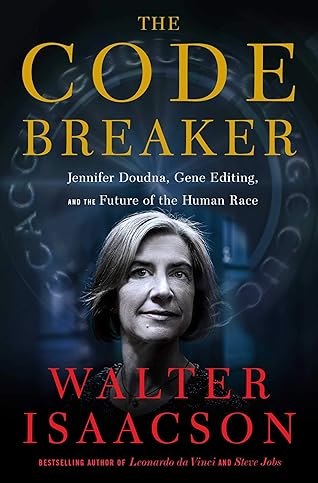More on this book
Community
Kindle Notes & Highlights
Read between
April 16 - April 24, 2022
make CRISPR-Cas9 chop up the DNA of a virus in a test tube.
just two components: the Cas9 enzyme and the crRNA.
tracrRNA was required for producing the crRNA guide.
the crRNA guide could be modified to target any DNA sequence you might wish to cut.
translational medicine.
was an actual human-made invention, not merely a discovery of a natural phenomenon.
fact that Doudna subsequently hurried to push her own team’s paper into print would cause a small controversy, or at least a few raised eyebrows, among some members of the CRISPR crowd.
When I ask Doudna about this, she readily agrees that she told the editors of Science there was a paper being submitted to a competing journal and requested that the reviewers accelerate their process.
some gaps in the Šikšnys paper
made no mention of the role of tracrRNA in the gene-cutting process.
So Virginijus and I, we had no hard feelings whatsoever.”
eukaryotic
Instead, gene therapy involved delivering into the patient’s cells some DNA that had been engineered to counteract the faulty gene that caused the disease.
Renee Kahl liked this
The goal was to edit the flawed sequences of DNA in the relevant cells of the patient.
Renee Kahl liked this
“nucleases.”
But in the CRISPR system, the guide was not a protein but a snippet of RNA.
The CRISPR systems worked in bacteria and archaea, which are single-cell organisms that have no nucleus. But that left the question: Would they work in cells that do have a nucleus, especially multicell organisms such as plants, animals, you, and me?
Renee Kahl liked this
This rather quick success could be taken as evidence, as Doudna and her colleagues would later argue, that making CRISPR-Cas9 work in human cells was an easy and obvious step that was not a separate invention.
There was one competition in Doudna’s life that stands out for becoming heated and then bitter: the race in 2012 to show how CRISPR could edit the genes of humans.
But when pressed, Charpentier admits that the competitiveness that Doudna exhibits is the force that drives most scientific pioneers, and thus science itself.
He was particularly interested in those enzymes, known as nucleases, that cut DNA.
Cong was still a student in Church’s lab, and Zhang wanted to make sure that he kept the idea secret, even from his advisor.
“Confidential Memorandum of Invention” to
the CRISPR found in many microbial organisms,”
By early 2012—before Doudna and Charpentier went online in June with their Science paper showing the essential three components of the CRISPR-Cas9 system—Zhang had made no documented progress. He
Also, Zhang had not yet figured out the full role of the pesky tracrRNA.
However, one of the discoveries reported by Doudna and Charpentier in their 2012 paper was that the tracrRNA has another important role: it needs to stick around in order for the CRISPR system to do the actual cutting of the target RNA.
Marraffini believed that they had a fruitful collaboration going,
What did Zhang know and do before Doudna and Charpentier published their CRISPR-Cas9 Science paper online in June 2012?
In a controversial article titled “The Heroes of CRISPR,” which I will discuss a little later in this book, Lander would tout Zhang’s importance.
Zhang bristles slightly when I ask if he was building on the Charpentier-Doudna discoveries. He had, he insists, been striving for more than a year to turn CRISPR into a gene-editing tool.
To Zhang, “a biochemistry experiment in a test tube” was meant as a disparagement.
Doudna makes the reverse argument, saying that some of the most important advances in biology come when the molecular components are isolated in a test tube.
They didn’t know until our paper came out what was necessary.”
They are both right. Cellular biology and biochemistry complement each other.
There is, however, evidence that in June 2012 he still had a long way to
When Zhang was embroiled with Doudna in a patent battle three years later,
We did not work it out before seeing your paper,
spring of 2012
They did not clearly prove that Zhang had succeeded in editing the cells because some of the results indicated otherwise.
“Feng cherry-picked the data,” he concludes. “They even had data that indicated an editing effect when Cas9 was not included.”
Renee Kahl liked this
In his January 2012 grant application, Zhang did not describe the full role of the tracrRNA. Likewise,
But he and the Broad Institute say that he was already experimenting with systems that linked the tracrRNA to the crRNA.
However, there is no clear evidence, and certainly no published evidence, that he had fully sorted out the precise components that were essential or that he appreciated the ongoing role of the tracrRNA
Renee Kahl liked this
She had never experimented with human cells,
Doudna realized, correctly, that using CRISPR to edit human genes was the next breakthrough waiting to happen.
Renee Kahl liked this
East was able to grow the necessary human cells and then began testing ways to get Cas9 into the nucleus. When she started getting the data from her experiments, she was not sure that they showed evidence of gene editing.
“When she showed me the data, it was immediately clear to me that she had beautiful evidence of genome editing by Cas9 in the human cells,”
tag proteins with nuclear localization signals to get them to go into the nucleus, which is what we did with Cas9.
codon


